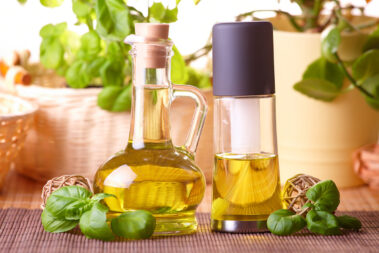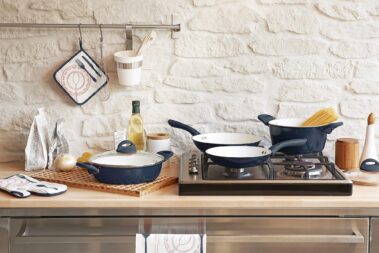One of the most nutritious things you can juice at home also happens to be one of the hardest things to juice. Of course, I’m talking about leafy greens.
These thin, lightweight superfoods are packed full of antioxidants, vitamins, and minerals, including calcium and iron. But effectively pulling the nutrient-rich juice out of greens takes a special kind of juicer. And even if you have the right kind of juicer, you aren’t guaranteed a high yield.
That’s exactly why we put together this list. Below, you’ll find the 6 best juicers for leafy greens on the market. We’ve included bargain picks as well as the best premier brands so you can efficiently juice greens at home no matter your budget.
Table of Contents
Our Picks at a Glance
- Top Pick: Omega NC800HDS Cold Press Juicer Machine
- Best Two Speed: AMZCHEF Slow Masticating Juicer Extractor
- Best Premier: Hurom H-AA Slow Juicer
- Best Budget: ORFELD Cold Press Juicer
- Most Compact: Elite Gourmet EJX600 Compact Masticating Slow Juicer
- Best Centrifugal Juicer: Breville Juice Fountain Cold Juicer
What to Look for in a Juicer for Greens
If you’ve followed any of our other juicer posts, you already know there are a lot of different types of juicers available. Each uses a different method to extract juices from produce.
When it comes to juicers for greens, though, there is only one type worth discussing and that’s a masticating juicer.
These “slow juicers” use an auger to grind and smash plant matter into a pulp. This pulp is then pressed against a strainer to release the liquid inside. Compared to other juicer types, such as citrus juicers and centrifugal juicers, this type is the most effective at removing liquid from stubborn leafy greens without compromising the nutritional content inside.
Please note: While we do our best to test all our reviewed products in person, some product reviews are compiled based on online user reviews and product descriptions.
The Best Juicers for Leafy Greens
1. Omega NC800HDS Cold Press Juicer Machine

The Omega NC800HDS Cold Press juicer tops our list for one simple reason: this thing performs.
This slow masticating juicer operates at a consistent 80 rpm for reduced oxidation and better nutrient retention and flavor. But it boasts a powerful 2-horsepower motor that exerts enough torque to break down fibrous leafy greens without a problem. It extracts the maximum amount of juice with minimal effort every time.
If you want to expand your juicing horizons, you can easily do it with this machine. The adjustable end cap allows for 5 different pressure settings. Whether you’re juicing kale and parsley or carrots and apples, you can expect perfectly dry pulp every time.
In addition to great-tasting juices, you can also make pasta, nut butter, baby food, and more. You can even grind coffee and herbs with this multi-talented machine.
The NC800HDS is the upgraded version of the popular Omega J8006HDC. The big differences between them are the carrying handle, feed chute size, and pressure nozzles. This one has a larger chute and two additional pressure settings which means less prep time.
These differences will cost you compared to the other model, but we think the upgrades are worth it.
Pros:
- Constant 80 rpm
- Large feed chute
- 5 pressure settings
- Carrying handle
- 15-year warranty
Cons:
- A bit bulky
- Premier price
- Customer service problems
2. AMZCHEF Slow Masticating Juicer Extractor

While a two-speed juicer isn’t necessary for juicing green vegetables, it’s nice to have this multi-speed option if you intend to juice a variety of produce.
The AMZCHEF slow masticating juicer gives you that option.
For leafy greens, the “hard” high speed runs at a perfect 100 to 110 rpm to efficiently crush and squeeze thin cell walls without dumping lightweight material. For oranges, watermelon, pineapples, and citrus fruits, switch the machine to the lower 50 to 60 rpm setting for optimal juice extraction.
All this is easy to control with the simple dial and LED control panel. For those tougher veggies that tend to bind up, you even have an option to reverse the flow if needed.
At both speeds, this juicer provides an impressive 90% juice extraction rate. The metal mesh strainer easily removes pulp and debris for smooth, nutritious juice with the great taste you crave.
As with our top pick, this juicer is well priced and perfect for anybody looking to get into juicing for the first time. Unfortunately, it does not come with a listed warranty and is made entirely of plastic. However, it has held up to our durability tests and other users have raved about its longevity.
Pros:
- Two speeds for variable use
- 100 to 110 rpm for leafy greens
- 90% juice yield
- Well priced
Cons:
- Made entirely of plastic
- No advertised warranty
- Takes some time to clean
3. Hurom H-AA Slow Juicer

If you’ve been juicing for a while and are interested in upping your game to better take advantage of those nutrient-rich greens, this Hurom slow juice is for you. This is easily one of the best juicers for leafy greens on the market.
This standup masticating juicer works a little differently than your typical horizontal models. The auger moves at a constant 43 rotations per minute. This extra-slow speed is offset by the large metal mesh filter basket which quickly removes juice to avoid oxidation.
Even with tricky produce like greens, this product produces bone-dry pulp. The Hurom may cost you more upfront, but if you’re juicing greens every day, you’re likely to save money in the long run. With each bunch of greens juiced you’ll extract juice more effectively than you would with any bargain juicer.
In addition to fruit juice, you can also use this impressive machine to make sorbet, nut milk, nut butters, and tofu.
No matter what you use it for, you won’t have to worry about cleanup. The wide filter basket and fewer small parts mean you can clean and rinse the parts in under 5 minutes.
The Hurmon comes in three great colors: black, white, and rose gold. All models are covered by a 10-year extended warranty.
Pros:
- Vertical design masticating juicer for easy use
- 43 rpm with extra-large screen filter
- Compact and stylish
- Super easy to clean
- 10-year warranty
Cons:
- Pricey
- Made mostly of plastic
4. ORFELD Cold Press Juicer

When it comes to budget juicers, most don’t perform well enough to effectively juice leafy greens. The ORFRLD cold juicer is one exception to this rule.
This budget juicer costs half as much as our well-priced top choice and still performs impressively well, whether you’re juicing wheatgrass or oranges.
The slow auger turns at a constant 90 rpm for smooth healthy juice and dry pulp every time. With most produce, you can expect a 92% juice extraction rate for a high juice yield. This number drops somewhat for green vegetables, but not by much.
Once you’re done juicing your kale, ginger, or spinach, this product is as easy as any to clean. Simply rinse all the smaller attachments and use the included cleaning brush to scrub out the filter.
Another bonus of this affordable juicer is it’s a little smaller than most, making it great for crowded kitchens or for keeping on the countertop for daily use. And with five colors to choose from—seafoam green, red, blue, dark blue, and white—you’ll have no problem matching it to your decor.
Pros:
- Inexpensive
- Steady 90 rpm
- Comes in multiple colors
- 92% juice extraction
- Easy to clean
Cons:
- Less durable than other options
- Made entirely of plastic
5. Elite Gourmet EJX600 Compact Masticating Slow Juicer

If you’re looking for an ultra-compact, space-saving juicer, look no further than the Elite Gourmet EJX600.
It doesn’t get any smaller than this personal-use juicer. It’s about the size of a water bottle but packs plenty of power for breaking down leafy greens. Despite the small size, it has one of the wider feed chutes we found.
The Elite Gourmet runs at a slow 70 rpm, which is perfect for wheatgrass and other greens. The slower speed and low-heat motor mean less oxidation and more nutrition. But this little juicer also produces wetter pulp than most.
Luckily, the solution to that is fairly simple. We just put the pulp back through two or three times and get out just as much juice as the more expensive options.
The other benefit of this little juicer is it takes much less time to clean. The parts are smaller which means less surface area. Plus, it’s super easy to store no matter how small your kitchen is.
For those who want to juice only greens for morning energy shots or who simply don’t have the space for a large juicer, the Elite Gourmet EJX600 is an excellent choice.
Pros:
- Portable and easy to store
- 70 rpm
- Wide chute
- Easy to clean
- Inexpensive
Cons:
- Pulp is fairly wet
- No pressure settings
- Simplified interface
6. Breville Juice Fountain Cold Juicer

Centrifugal juicers are not the best juicers for leafy greens. The fast-spinning blades tend to throw light greens out before they get pulverized. But these juicers also have the benefit of being much faster and easier to clean than masticating juicers.
If you need something that can produce speedy results while still performing well with leafy greens, the Breville Juice Fountain is a great choice.
This ultra-sleek upright juicer uses cold-juicing technology to quickly extract liquid without heating it. While this juice is more oxygenated than masticated juice, it retains more nutrients and intact enzymes than competitors. And the quick-spinning, fine Italian mesh filter delivers tons of pulp-free juice in a fraction of the time.
Another thing to love about this juicer is the wide chute. You can save even more time preparing your morning juice because you won’t have to precut most produce.
The sharp blades and powerful motor of this juicer handle greens better than most centrifugal options. But for the best results, we recommend sending your greens down wedged between two larger pieces of produce. This increases contact time with the blades and raises your juice yield significantly.
The Breville Juice Fountain features a tight-fitting, large-capacity pulp catch and a huge 70 fl oz juice catch. The simple dial knob has a high and low setting for soft and hard produce.
While this juicer is easily the bulkiest on our list, it’s also the fastest. If you have limited time to prepare your juice in the morning, the Breville Juice Fountain is worth the extra storage space.
Pros:
- Fast centrifugal juicer
- Very wide chute
- Cold-juicing technology
- Dishwasher safe components
- Easy to clean filter basket
Cons:
- Fast spinning action oxidizes juice
- Need to put greens in with heavy produce to increase yield
- Bulky
How to Choose Your Best Juicer for Leafy Greens
Finding the right juicer to fit your needs and budget can be tricky. It’s even harder when one of those needs is to be able to juice leafy greens effectively.
Here are a few things you need to consider when looking for a new quality juicer for leafy greens.
Type
As we mentioned above, the best type of juicer for green vegetables is a masticating juicer, also known as a cold juicer or slow juicer. But it’s possible to use other types of juicers with greens, they just come with more drawbacks.
Masticating Juicers
These are the best types of juicers for leafy greens. They work by smashing small pieces of produce against an auger. The product is “chewed” down into pulp and forced against a fine mesh screen to extract the juice.
On the plus side, these slow juicers create juice with minimal oxidation and maximum nutrient and enzyme retention. They are also fairly quiet—usually producing below 60dB of noise. On the downside, they are slow and require a lot of prep work to chop produce so the pieces will fit into the small chute.
Centrifugal Juicers
Centrifugal juicers, also known as fast juicers, use a sharp grater-like blade to pulverize produce. The shredded product is then forced against a fast spinning mesh filter to remove the liquid from the pulp.
These juicers tend to be affordable and work very quickly. They also require less prep work since the feed tube is larger and the blade can quickly reduce whole fruits and veggies into pulp.
But the centrifugal motion tends to cast out thin, lightweight greens without shredding them, which means less juice is produced. They also reduce the nutrient content of the juice by oxidating and heating enzymes and vitamins.
Twin Gear Juicer
Twin gear juicers work similarly to masticating juicers but use two augers instead of one. This results in more nutrients being transferred into the juice. Due to the setup of the mesh screens, however, it also means more solids end up in the juice.
When it comes to juicing greens, this retention of solids can be very problematic since much of the stringy greens material ends up in the final product. These juicers also tend to be pretty pricey and very bulky.
On the plus side, these types can do a lot more than juice. They’re also good for making nut butter, baby food, and more.
Speed
The speed of your juicer is another important factor when it comes to juicing greens.
When a juicer spins too fast, it creates heat that can harm the vitamins and enzymes in the juice. These important nutrients are the reason green juice is so healthy, so it’s important to keep them intact.
Fast juicers also tend to inject oxygen into the juice which creates froth and diminishes how long the juice will last after it’s made. Oxidation lowers the nutrient content and reduces the effectiveness of the antioxidant flavonoids inside.
Juicers that rotate too slowly are also problematic because they struggle to effectively break down the greens which means nutrients and juice remain locked inside the pulp.
The best juicers for leafy greens rotate between 80 and 110 rpm. Juicers that spin slower than this need additional means for removing juice from the pulp, such as a large, upright basket. This design is how the Hurom H-AA Slow Juicer still effectively juices greens even though it only spins at a speed of 43 rpm.
Ease of Cleaning
Masticating juicers like those we featured above tend to be fairly easy to clean compared to centrifuge juicers. But they still have a lot of parts that must be rinsed and occasionally scrubbed.
The hardest part of the cleaning process for any juicer is the mesh filter. The larger the filter, the more surface area will need cleaning. And the finer the filter, the harder it will be to clean. These drawbacks need to be considered against the benefits that typically come with a larger, finer strainer.
The overall cleaning time for masticating juicers is going to be fairly comparable between models with a few exceptions.
Storage
The last thing to consider when looking for a new juicer is how and where you want to store it.
If you’re going to be juicing daily, then finding a unit that stores easily on the countertop without taking up too much room is a good idea. The AMZCHEF Slow Masticating Juicer Extractor Professional is perfect for this type of storage and comes in a ton of great colors to match any decor.
If, on the other hand, you’re only going to be juicing occasionally or don’t have counter space to spare, you’ll want to find a juicer that can be easily stored in a cupboard.
Depending on the setup of your storage area, an upright juicer like the Hurom may be the easiest option. Or you may be better off with a unit that breaks down into separate pieces like the AMZCHEF Slow Masticating Juicer Extractor.
Which Juicer Is the Best for Leafy Greens?
We found a lot of great juicers on our mission to track down the best juicer for leafy greens. But the clear winner in this category was definitely the Omega NC800HDS Cold Press Juicer Machine.
Not only does the Omega produce an impressive amount of juice, but it does so while maintaining the integrity of the nutrients and enzymes thanks to a constant 80 rpm rotation. Equally important, this versatile juicer can be used for numerous other purposes, which makes it the best bang for your buck.
Can’t Get Enough Fresh Juice??
Still looking for the perfect juicer? Or maybe you want one that can take on a different kind of produce. Check out these articles for more “best of” juicer recommendations.







